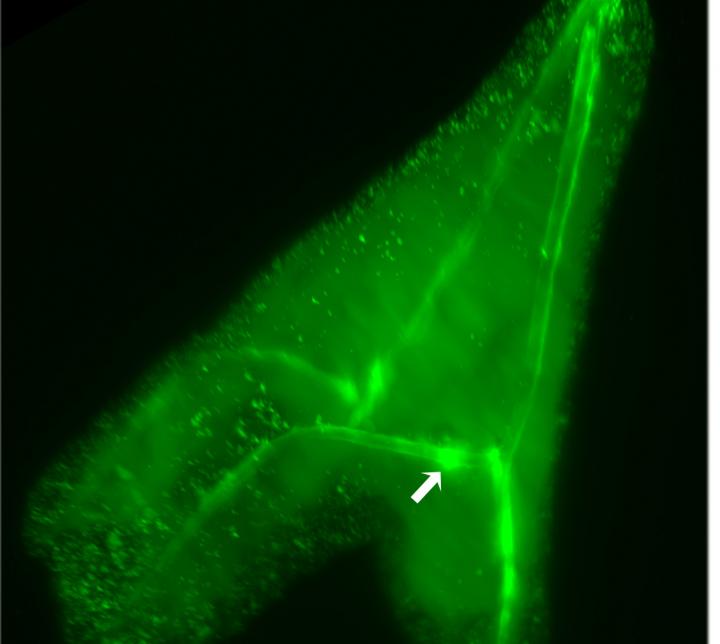Making spines from sea water

The green fluorescent label maps the distribution of calcium in sea urchin larvae. The label shows the elongated mineralized spicules and vesicles with large amounts of calcium. Credit: Weizmann Institute of Science
Some sea creatures cover themselves with hard shells and spines, while vertebrates build skeletons out of the same minerals. How do these animals get the calcium they need to build these strong mineral structures? Professors Lia Addadi and Steve Weiner of the Weizmann Institute of Science's Structural Biology Department asked this question about sea urchins, which need to extract quite a few calcium ions from sea water to build their spines. The answer surprised them, and it could change the way scientists think about the process of biomineralization.
Several years ago, Addadi and Weiner had discovered that sea urchins build their spines with tiny packets of “unorganized” material that hardens into crystal when laid in place. “So the question went back a step: How do they get the calcium ions they need to make this material in the first place?” says Addadi. “Free calcium is not abundant in sea water,” adds Weiner, “so they need an efficient way to extract and concentrate the ions.”
To answer the question the researchers, including Netta Vidavsky, needed methods to observe the animal's cells “as is,” that is, as they are in life, water included. For this the group turned to Dr. Andreas Schertel of Carl Zeiss Microscopy in Germany and Dr. Sefi Addadi of the Weizmann Institute of Science's Life Sciences Core Facilities. Very new cutting-edge techniques enabled them to observe thin slices of the cells in sea urchin embryos and then to reconstruct three-dimensional images of these cells and their intake of labeled calcium ions. “Even a few years ago, we could not have done this study,” says Addadi.
The images showed that sea urchin larval cells actually “drink” seawater, taking in drops of water and manipulating the ions in the water within the confines of the cell. This is in contrast to the theory that these cells take in only ions, one at a time, through special channels in their outer membranes. The cells they observed were filled with networks of bubbles called vacuoles that collect the calcium ions, evidently creating concentrated packages of calcium for building the spines.
This method may be more energy efficient than taking in ions through channels (which the cells also did), but it presents another problem: The cells must be able to pick out the calcium as well as expel other ions in the sea water, especially the sodium and chloride. “Researchers may be busy for years to come figuring out how these cells manipulate the ions in the sea water they drink,” says Weiner.
Addadi and Weiner point out that this is not the first time this type of calcium ion intake has been observed. Prof. Jonathan Erez of the Hebrew University of Jerusalem had described this phenomenon in single-celled, hard-shelled microorganisms called foraminifera a decade ago. At the time, it was thought to be a “curiosity,” but finding the same process in two very different creatures suggests that it may be quite widespread. Although we do not live in sea water, even the cells that build our bones may use a similar method to obtain calcium.
###
Prof. Lia Addadi's research is supported by the Jeanne and Joseph Nissim Foundation for Life Sciences Research. Prof. Lia Addadi is the incumbent of the Dorothy and Patrick Gorman Professorial Chair.
Prof. Stephen Weiner's research is supported by the Helen and Martin Kimmel Center for Archaeological Science, which he heads; the Dangoor Accelerator Mass Spectrometer Laboratory; and the estate of George and Beatrice F. Schwartzman. Prof. Weiner is the incumbent of the Dr. Walter and Dr. Trude Borchardt Professorial Chair in Structural Biology.
The Weizmann Institute of Science in Rehovot, Israel, is one of the world's top-ranking multidisciplinary research institutions. Noted for its wide-ranging exploration of the natural and exact sciences, the Institute is home to scientists, students, technicians and supporting staff. Institute research efforts include the search for new ways of fighting disease and hunger, examining leading questions in mathematics and computer science, probing the physics of matter and the universe, creating novel materials and developing new strategies for protecting the environment.
Media Contact
All latest news from the category: Interdisciplinary Research
News and developments from the field of interdisciplinary research.
Among other topics, you can find stimulating reports and articles related to microsystems, emotions research, futures research and stratospheric research.
Newest articles

You are What You Eat—Stanford Study Links Fiber to Anti-Cancer Gene Modulation
The Fiber Gap: A Growing Concern in American Diets Fiber is well known to be an important part of a healthy diet, yet less than 10% of Americans eat the minimum recommended…

Trust Your Gut—RNA-Protein Discovery for Better Immunity
HIRI researchers uncover control mechanisms of polysaccharide utilization in Bacteroides thetaiotaomicron. Researchers at the Helmholtz Institute for RNA-based Infection Research (HIRI) and the Julius-Maximilians-Universität (JMU) in Würzburg have identified a…

ASXL1 Mutation: The Hidden Trigger Behind Blood Cancers and Inflammation
Scientists show how a mutated gene harms red and white blood cells. LA JOLLA, CA—Scientists at La Jolla Institute for Immunology (LJI) have discovered how a mutated gene kicks off…



